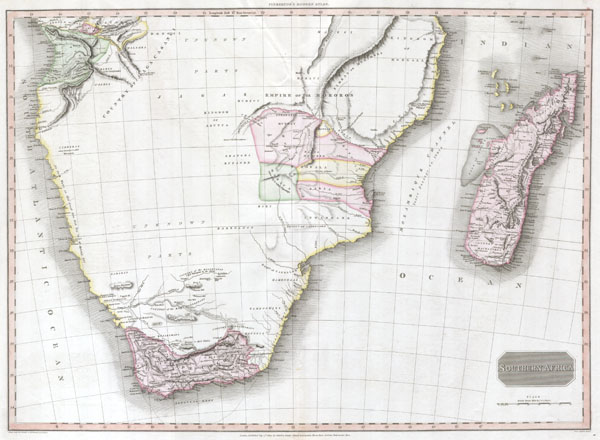This item has been sold, but you can get on the Waitlist to be notified if another example becomes available, or purchase a digital scan.
1809 Pinkerton Map of Southern Africa
SouthernAfrica-pinkerton-1809
Title
1809 (dated) 20.5 x 28 in (52.07 x 71.12 cm)
Description
The Congo had been actively mapped and exploited by Portuguese merchants as early as the 14th century. South Africa, similarly, had an active Dutch and English presence since the earliest days of African Colonization.
The ancient Kingdom of Monomotapa, here part of the Empire of the Bororos and divided into Sabia, Sofala, Munhay and Manica, appears on most early maps of Africa. Already a great trading Empire when Vasco de Gama rounded the Cape of Good hope in the 1490s, Monomotapa or the regions between the Sabia, Sofala and Zambezi River systems, had long been associated with legends of King Solomon's Mines and the Biblical lands of Ophir. In the 15th century the Zambezi hills were indeed rich in gold, but these deposits had run out by the 1600s. Still, the European imagination, inflamed by conquistador tales of golden empires in America, made several attempts to conquer the region, only to find that there was no more gold to be had.
In other areas of Africa's interior Pinkerton notes an embryonic Lake Malawi (named Maravi), and notes several important African tribal nations, including the Massai, the Hottentots, the Bembe, and the Luba (Lubolo).
Cartographer
John Pinkerton (February 17, 1758 - March 10, 1826) was an Scottish writer, historian, and cartographer. Pinkerton was born in Edinburgh, Scotland. He was a studious youth with a passion for the classics. As a young man, he studied at Edinburgh University before apprenticing as a lawyer. Around this time, he began writing, with his first book, Elegy on Craigmillar Castle published in 1776. Pinkerton moved to London in 1781 to pursue his writing career in earnest. He successfully published several works of literature, poetry, and history. Pinkerton proved passionate in his literary and historical writings, but his correspondence with other cartographers has been labeled as aggressive, even insane. In addition to his work as a writer and historian, Pinkerton was one of the leading masters of the Edinburgh school of cartography which flourished from roughly 1800 to 1830. Pinkerton and his contemporaries (Thomson and Cary) redefined European cartography by abandoning typical 18th century decorative elements such as elaborate title cartouches and fantastical beasts in favor of detail and accuracy. Pinkerton's principle work is Pinkerton's Modern Atlas published from 1808 through 1815 with a special American reissue by Dobson and Co. in 1818. Pinkerton relocated to Paris in 1818, where he managed his publishing business until his death in 1826. More by this mapmaker...

